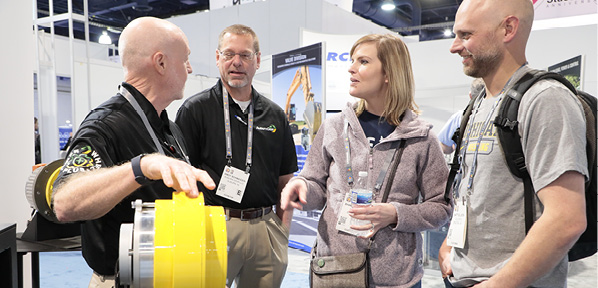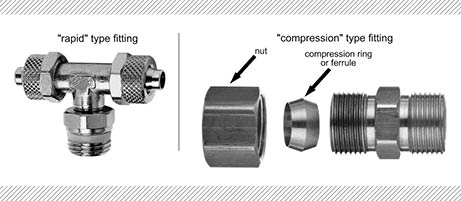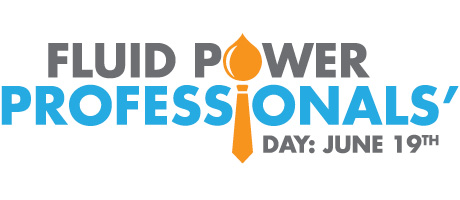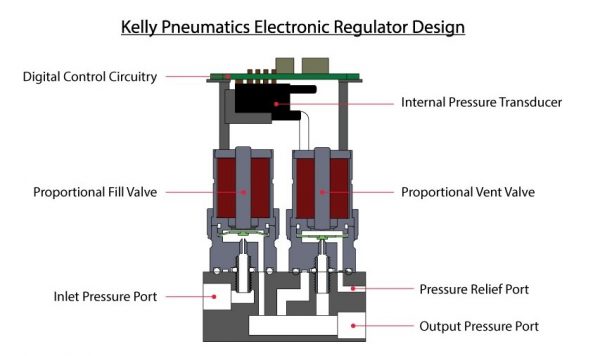2016 Manufacturing Q&A
 Jess Penny is general manager of sales for Penny Hydraulics, Ltd., a lifting-equipment manufacturer in the United Kingdom. Her role is to develop and implement the company’s sales and marketing strategy, and she is responsible for revenue generation across the vehicle mounted lifting equipment range in the UK and overseas. Penny Hydraulics is a family business, and Ms. Penny is a third-generation family member. She is a marketing graduate with eight years of industry experience.
Jess Penny is general manager of sales for Penny Hydraulics, Ltd., a lifting-equipment manufacturer in the United Kingdom. Her role is to develop and implement the company’s sales and marketing strategy, and she is responsible for revenue generation across the vehicle mounted lifting equipment range in the UK and overseas. Penny Hydraulics is a family business, and Ms. Penny is a third-generation family member. She is a marketing graduate with eight years of industry experience.

Phil Wyrembelski has more than 40 years of experience in the electrical industry. Before his current role as business development manager at Danfoss Drives, Mr. Wyrembelski held positions including business lead – food and beverage, drives sales leader, and high-power business lead. He has presented numerous technical papers in the area of automation.

Frank Langro is director of marketing and product development at Festo, where he has represented the company in multiple areas of support for the advancement of fluid power. He has participated in the development of national and global standards as a member of the NFPA, and he represents Festo as an Industrial Advisory Board member for CCEFP. Mr. Langro holds four patents in fluid power and attained a BS degree in Mechanical Engineering from Hofstra University.

Matt Harmeyer is product manager of advanced technologies for PHD, Inc., a manufacturer of actuators for industrial automation. His role is to monitor industry and market trends as they apply to future PHD plastic packaging components and clamp product lines, and he is responsible for the engineering development of those product lines. Mr. Harmeyer has a Mechanical Engineering Technology degree from Purdue University with 20 years of industry experience.
Are manufacturing companies poised for growth in 2017?
Penny: Speaking from the point of view of a business with over 35 years of experience in our field, the single market has massively simplified trade within Europe, raised standards, lowered prices, and brought Europe much closer together. With the referendum drawing close, we are currently going through a period of considerable uncertainty in the UK even though the economic situation is good. The UK could face years of uncertainty as treaties are unpicked and new ones negotiated. If trade deals were less favorable than they are now, then some major manufacturers may move out of the UK. So although the projections are good for Penny Hydraulics, the importance of remaining within the EU should not be overlooked. Should we depart from the EU, we may not just see the rate of growth deteriorate, but we may also see a decline.
Wyrembelski: In general, no. During the past five years, the Gross Domestic Product has been under 2.5%, and with an adjusted GDP for the first quarter of 2016 at .08, manufacturers are reluctant to grow and expand. Investment programs have almost come to a stop, and resource reduction will come into play if the economy stays at its present level.
Langro: I believe many companies are preparing to be in a position to capitalize on the expected upswing in the U.S. market that may come later in 2016 and into 2017. The manufacturing companies are demanding more flexibility and intelligence in their capital equipment expenditures, challenging the OEMs to come up with new concepts and evaluate new technologies. Manufacturers are constantly striving for greater operational efficiencies.
Harmeyer: Yes. The U.S. manufacturing base grew rapidly coming out of the recession, but growth has slowed. However, manufacturing is still on the rise, and with the past as a guide, manufacturers should be prepared to address continued growth requirements that they have experienced over the last five years.
Which product segments of the manufacturing market are growing, and which segments are diminishing?
Penny: During the recession, there was a vast reduction in commercial vehicles being manufactured, which saw a downturn in the need for vehicle mounted lifting equipment. Vehicle mounted cranes and loading platforms was our core business, and therefore this could have potentially been catastrophic for us. At the same time during the recession, we saw a definite rise in our goods lift division, as there was a trend for business owners to expand and develop their existing premises rather than undertake the larger investment to move premises at a time of major financial uncertainty. This meant, in a lot of cases, that business owners were having a mezzanine floor installed in their buildings for extra storage or work space, which then meant there was a requirement for a lift to move goods to and from this area. Our goods lift division is now a key growth area for us.
The downturn of the coal mining industry in the UK resulted in a fall in sales of our hydraulic roof supports and other mining products, and triggered our subsequent expansion into mechanical handling for the nuclear power industry, resulting in the “Penny nuclear” division being setup.
Wyrembelski: A few areas of growth will fall into four different segments: data, food & beverage, chemical & plastic, and automotive. Almost every new device developed today has the need to store information or communicate with one another. Data centers globally are expanding annually because of the thousands of new nodes added to the world’s networks daily.
The economy seldom affects food and beverage, so if it’s not growing, it’s usually stable. Chemical and plastic is another strong industry segment that is usually stable, if not growing, in the best or worst of times. Automotive is on the verge of becoming a growth industry at minimum sustaining. During the last 10 years, many vehicle owners have kept their vehicles longer than ever before, but now the need for new purchases is coming. Also the need for continuous quality improvements and innovation will help drive market share. So upgrades and new expansion will keep this industry strong.
As for manufacturing segments today, oil & gas, and metal & mining are a few segments showing decline. When speaking of declining industries, these segments often rely on one another, such as marine support for offshore oil and gas. The oil and gas segment has been significantly affected by supply and demand—too much supply and too little demand. As mentioned earlier, a weak demand globally for energy products is due to the slowdown in economic global growth. With weak demand comes a lower price, which equals lower profits, which causes resource and monetary reductions. Mining and metals falls into a similar pattern where precious metals are negatively affected when global economies slow down and consumers stop buying. The need for iron, copper, lead – and let us not count out the precious metals gold, silver, rhenium, ruthenium, etc., which are used in the manufacturing of heavy products, as well as electronic, plating, and coatings – all suffer with weak economies.
Langro: Clearly the U.S. oil and gas industry has faced many challenges with the current low price of oil. This has cut into extraction and minimized the need for equipment. The print industry continues to be negatively impacted by digital media platforms, which further reduces equipment needs.
The packaging industry remains quite stable in growth as packagers look at how to make packaging lighter and reduce waste. The gains throughout the supply chain from this can be significant and has been an incentive for machine builders to improve their equipment offerings. Also, automation in the medical lab market continues to grow as the demand rises for new drugs and diagnostic testing. The constant flow of new products and technology in consumer electronics has created shorter product lifecycles and increased the demand for highly automated yet flexible machines. Another industry with a backlog of orders is the airline industry. The opportunity is available for automation to increase the productivity of these manufacturers.
Harmeyer: Automation is growing. With the increase in healthcare costs gripping many manufacturers, they are looking to automate manufacturing processes to support growth while maintaining a level workforce volume.
What are the greatest technology challenges to manufacturing growth in the next 6-to 12 months, and how can companies handle those challenges?
Penny: Manufacturing faces increased regulation and compliance measures. Regulations can be a huge burden to manufacturing companies, especially small and medium enterprises that perhaps don’t have the money or resources to implement any required changes. Even for larger organizations, regulations may vary from country to country, which may prove challenging.
More than ever before, manufacturers must ensure total visibility throughout their supply chain for their own compliance and that of their suppliers. Regulations often require the ability to track items and materials used during the full manufacturing process. This can be time-consuming work. Awareness of relevant regulations, managing compliance reporting, and traceability is an ongoing challenge for manufacturers, and many companies now dedicate whole teams to stay ahead of new rules and ensure the necessary paper trails are in place.
With innovation and product development being key to any successful manufacturer to stay ahead of the competition, it may be tempting to compromise on quality. Manufacturers must be stringent and avoid cutting corners at all costs. Implementing procedures that maintain a steady flow of new ideas in the pipeline is essential to success.
Wyrembelski: One challenge is to have a workforce available to grow technical industries because, in the next 5 to 10 years, many of the skilled trades and technology workforce will retire. Another is to stay ahead of the Internet of Things. We need to be educated and be willing to proactively join the conversation.
Langro: Aside from the political uncertainty in the U.S. hampering business decisions, the technology challenges are coming from two directions. One major challenge is how to bring the potential of smart manufacturing or the Industrial Internet of Things (IIoT) into reality on the shop floor. The other challenge is to teach workers the proper skill-sets required to operate and maintain advanced manufacturing equipment.
The IIoT opens up the possibility of advanced diagnostics and remote monitoring and control that can impact not only machine productivity but also improve the efficiency of the supply chain. A challenge here is the concern with data security. Clearly some of the recent highly public security breaches, such as what occurred at the Sony Corp., have created concern among manufacturers about the efficiency of having operational data and process control parameters remotely accessible through the Internet. Threats from outside the organization can only be overcome through implementation of diligent security measures, which means the companies will need certain infrastructures in place to put the power of IIoT into action. Not all companies have this security in place.
The second major technology challenge is providing the workforce with the skills necessary to operate and maintain the high-tech manufacturing equipment increasingly prevalent in today’s manufacturing plants. Training and continuous education of the workforce is really the only way to prepare employees for the challenges they will face.
There are primarily two educational sources that companies can leverage. Industrial companies, such as Festo, offer training in the various manufacturing skills necessary to maintain and operate machines. Another solution is to work with local community colleges to provide curriculum specifically suited to the manufacturers in the local region. Central Piedmont Community College in the Charlotte, N.C. area, for example, has worked with companies to develop a program suited to the needs of the local manufacturers. This approach is modeled on the successful apprenticeship system practiced in Germany.

Are manufacturing companies doing enough to meet the energy and efficiency demands of the market?
Penny: Most manufacturing companies are committed to minimizing the environmental impact of their operations and products through the adoption of sustainable practices and continuous improvement in environmental performance. For one, being able to demonstrate a sound environmental and sustainable policy is a pre-requisite to working with most blue-chip companies.
While it is undeniably good news for the local environment and employee wellbeing, sustainability and environmental regulations can be expensive for manufacturing firms. Manufacturers need to be aware of these costs when outlining their quarterly budgets.
Wyrembelski: Most of our larger manufacturers are buying what is available to improve their positions as energy efficiency demands grow. Whether it’s lighting, motors, or gearing with variable-speed drives, U.S. companies apply these technologies daily. Can we do better? Yes, and we need to continue to educate ourselves and our customers on available solutions.
Langro: I believe that manufacturers are continuously searching for savings and areas where they can improve their bottom line. We have seen machine builders take steps to be more precise in their selection of components to ensure minimizing energy usage. At Festo, where we specialize in industrial automation solutions, we are often asked by manufacturers to review their installed equipment and look for ways to generate operational savings. Sometimes this can be achieved through simple isolation of certain parts of the machine during downtime.
Harmeyer: U.S. energy prices are low relative to many other industrialized countries. Due to low energy costs, I feel that the U.S. lags many other countries regarding reducing energy usage. Therefore, I do not believe there is enough pressure for manufacturers to reduce energy costs.
What do you think is the best way to handle the workforce crisis in manufacturing, and how can we attract young workers into this industry?
Penny: The promotion of engineering as a brilliant and exciting career needs to start at an early age. We do our part by organizing school visits from primary and secondary schools. Five work experience placements are offered per year, and typically it is the pupils from the village school who take these placements. We also have involvement with the local colleges, such as Chesterfield College, sponsoring their Engineering Department Celebration of Achievement event.
It is well known that there is a national shortfall of engineers, and it is becoming increasingly difficult for us to find good candidates. It is a big challenge for small and medium enterprises to attract high-caliber engineers when we have to compete against the large, prestigious blue-chip companies that are attractive to graduates.
For almost a decade, Penny Hydraulics has been involved with Sheffield Hallam University as part of its Knowledge Transfer Partnership Scheme. This has enabled us to offer valuable industry experience to engineers with little or no practical experience and recruit high-caliber graduates to run well-defined projects within our company.
Wyrembelski: Here are some thoughts:
- Pay a proper skilled trades wage to those who qualify.
- Provide skilled training at the high school level before graduation. Start early.
- Promote college, but not as the “only” alternative for a quality life.
- Continue to support the re-shoring efforts to bring good manufacturing jobs back to this country.
- Be relevant. Expand your digital presence. Promote your brand…who you are. Have fun.
Langro: The new technology on the plant floors brings new opportunities to the plant workers; continued education is the way to keep workers productive and engaged. It is never too early to foster and cultivate an interest in technology. There are various programs, such as FIRST Robotics and the NFPA’s Fluid Power Challenge, both of which offer high school students a chance to gain first-hand experience with fluid power and automation technology. Events such as Manufacturing Day, where companies give tours and discuss the role they play in manufacturing, help to create the awareness of careers in manufacturing. In each of these cases, it is important for today’s professionals to help inspire tomorrow’s workforce.
Harmeyer: The best way to handle the workforce crisis in manufacturing is with education, both for young people entering the workforce and for seasoned workforce veterans who need or want to increase their skill-set to keep up with changing technology. Employee education reimbursement programs are an effective method to do so.
We must teach young students that STEM-related professions are great, satisfying careers that pay well. Engineering degrees command the highest wages of any four-year degree. Engineering-focused programs and extracurricular activities in high school is a great start.
Kids watch a lot of television, which glamorizes investigators, doctors, and lawyers. Have you seen a controls engineer as the focus of a television show? This is why it is imperative to educate young students in school about how they can contribute to society as an engineer. Most kids don’t know that engineers developed the smartphones, tablets, and televisions that they use every day.







